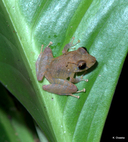|
Description
Males 16-20 mm, females 20-27 mm. The dorsum is yellow to brown with irregular dark markings. Generally a W- or H-shaped mark is present in the scapular region. There are transverse bars on the forelimbs. The ventral surface is grayish. The throat region has diffuse dark markings. The iris is brown or reddish. Distribution and Habitat
Country distribution from AmphibiaWeb's database: Bolivia, Brazil, Colombia, Ecuador, Peru
Occurs throughout the Reserva Florestal Adolpho Ducke in Brazil, but is rarely encountered.Life History, Abundance, Activity, and Special Behaviors
The species is arboreal and nocturnal. Reproduction occurs in the rainy season (November to May). Males start calling at dusk from vegetation about 2 m above the ground. Females deposit about 25 large eggs. Development to metamorphosis occurs in the eggs. Comments
Similar species: Pristimantis fenestratus has a cream ventral surface, and a gray throat region with dark markings. Pristimantis zimmermanae does not have transverse bars on the forelimbs, its dorsum is greenish, and its ventral surface is yellowish with tiny golden dots.
Originally submitted by: Albertina P. Lima, William E. Magnusson, Marcelo Menin, Luciana K. Erdtmann, Domingos J. Rodrigues, Claudia Keller, Walter Hödl (first posted 2007-12-05)
Edited by: Kellie Whittaker (2007-12-12)Species Account Citation: AmphibiaWeb 2007 Pristimantis ockendeni <https://amphibiaweb.org/species/3092> University of California, Berkeley, CA, USA. Accessed May 31, 2025.
Feedback or comments about this page.
Citation: AmphibiaWeb. 2025. <https://amphibiaweb.org> University of California, Berkeley, CA, USA. Accessed 31 May 2025.
AmphibiaWeb's policy on data use.
|
